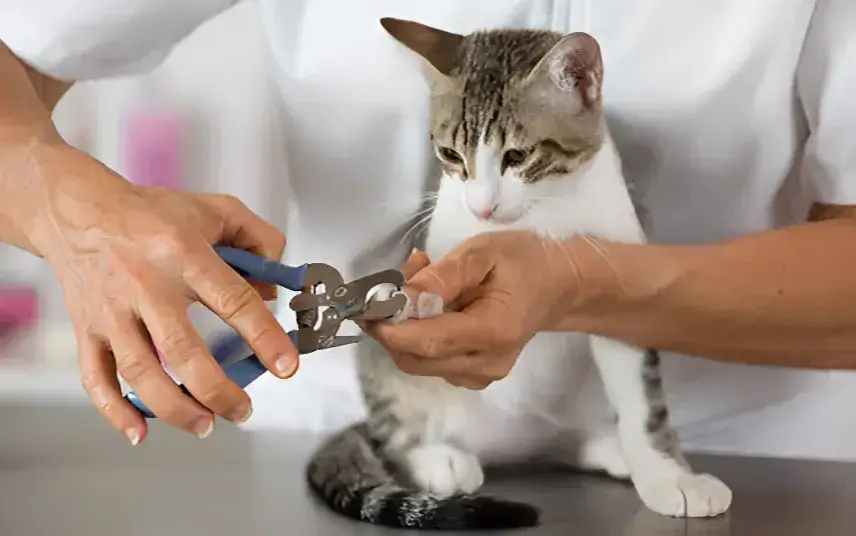Keeping your cat’s claws trimmed is essential for their comfort and your furniture’s safety. While it might seem daunting, with the right approach you can turn nail trims into a positive experience for both of you.
Why Trim Cat Claws?
- Prevent Overgrowth: Claws that grow too long can curl into paw pads, causing pain and infection.
- Reduce Damage: Sharp claws can lead to accidental scratches and snagging on furniture and textiles.
- Promote Healthy Movement: Overgrown nails can alter your cat’s gait, leading to discomfort.
Supplies & Preparation
- Choose Your Weapon: Cat nail clippers come in scissor, guillotine, or plier styles. Find one that feels comfortable in your hand.
- Styptic Powder (Just in Case): This quickly stops bleeding if you accidentally cut the quick.
- Treats Galore: Your cat’s favorite snacks are a must for positive reinforcement.
- Timing is Key: Opt for a time when your cat is relaxed, such as after a play session or nap.
Why Do Cats Dislike Nail Trims?
Many cats dislike having their paws handled, and the unfamiliar feeling of clippers can be scary. Negative experiences from past trims can also make them resistant. By creating a calm atmosphere and using positive reinforcement, you can overcome this aversion.
How to Locate the Quick
The quick is the pink, blood-filled part of the nail. Cutting it is painful – here’s how to avoid it:
- Squeeze and See: Gently press on the top and bottom of the paw pad to extend the nail.
- Find the Pink: Look for the pink area inside the nail. (Include a simple diagram of a cat claw with the quick labeled here)
- Safety Zone: You’ll only be trimming the clear, sharp tip.
The Stress-Free Trimming Technique
1. Get Cozy: Settle in a quiet place with your cat on your lap or a comfortable surface.
2. Pawsitive Handling: Gently hold one paw, giving it a light massage.
3. Extend and Clip: Press on the paw pad to extend a claw. Clip just the clear tip, well before the quick. Hold the clippers perpendicular to the nail for a clean cut.
4. Treat and Repeat: Offer a treat after each claw, taking breaks as needed. Start with a few claws at a time and gradually increase over sessions.
Watch: How to Trim Your Cat’s Claws
For a step-by-step visual guide, check out this excellent video: How to Safely Trim a Cat’s Nails | Vet Tutorial:
Key Takeaway: Remember, the video demonstrates the importance of positive reinforcement. Treats and praise go a long way!
Common Mistakes & How to Avoid Them
- Trimming Too Close: This can cause pain and bleeding. Always aim for a small snip of the clear tip.
- Using Dull Clippers: Dull clippers can crush the nail, making the experience uncomfortable. Invest in sharp clippers designed for cats.
- Forcing a Fearful Cat: This creates a negative association. Be patient, take breaks, and reward calm behavior.
Help! My Cat is a Ninja Warrior
- The Comfy Cocoon: For extra wriggly cats, gently wrapping them in a towel can create a sense of calm and reduce their escape attempts.
- Delicious Diversions: Enlist a friend or family member to offer high-value treats or wave an irresistible toy while you snip.
- Baby Steps to Brave Kitty: Make paw handling a positive part of your daily routine with rewards. Slowly introduce the clippers, just making a clicking sound, and reward calm reactions.
- Small Victories: Don’t aim to conquer all the claws in one go. Short, successful sessions build trust and pave the way for easier trims in the future.
Oops! I Cut the Quick
Don’t Stress, Address: Quick cuts happen! Apply styptic powder, a pinch of cornstarch, or even a dab of gentle bar soap to stop the bleeding. For severe bleeding, contact your vet for advice.
Building a Paw-sitive Association
- Treats = Nail Trims: Each step of the process deserves a tasty reward.
- Praise Party: Offer gentle praise in a soothing voice throughout the process.
- Playtime After: Engage in a fun play session afterward to reinforce positive feelings.
When to Call in the Pros

If your cat is overwhelmingly resistant or has health sensitivities, a veterinarian or experienced groomer has specialized techniques and tools to make nail trims safe and less stressful.
Alternative Techniques
While regular nail trims are essential, scratching posts and soft paws (nail caps) can offer supplementary solutions, especially for indoor cats. Scratching posts help satisfy your cat’s natural scratching instinct and promote healthy claw wear. Soft paws are glued-on caps that can help protect furniture and are a good option for some cats, but regular nail trims are still recommended to prevent overgrowth.
Expert Quote:
“Prioritizing regular nail trims is vital for cats. It’s more than couch protection; it’s ensuring your feline friend’s overall health and well-being.” – Dr. Donna Malone (DVM)
Conclusion
Nail trimming can be a positive experience for both you and your cat. With patience, positive reinforcement, and the right approach, you’ll help keep your furry companion healthy and happy, one paw at a time.
The photo featured below the post headline is Credit: Eduardo Gonzalez/gettyimages
I hope you find this post helpful and informative. If Yes’ feel free to share it with your friends!
Frequently Asked Question
How often should I trim my cat’s claws?
Generally, every 2-3 weeks is ideal.
Can I use regular nail clippers?
Human clippers can crush cat claws, so always use ones designed for pets.
What if my cat hates being held?
Start with super short desensitization sessions with just positive handling.
Is it necessary to trim a cat’s claws?
Yes! Untrimmed claws can grow too long, causing pain, snagging on furniture, and altering your cat’s walking patterns.
What to do if your cat won’t let you cut their nails?
Be patient and focus on desensitization. Start with short sessions handling their paws, introduce the clippers with treats, and reward any calm behavior.
What angle do you trim a cat’s nails?
Aim to cut perpendicular to the nail, getting just the sharp tip without going near the quick.
Do scratching posts trim cats nails?
Scratching posts help wear down nails but usually don’t eliminate the need for regular trims.
How to trim angry cat claws?
Patience is key. Try the towel burrito method, distraction with treats, and only trim a few nails at a time to build up their tolerance.
How to trim my cat’s claws for the first time?
Start slow! Find a quiet time, handle your cat’s paws gently, and only attempt one or two nails at first. Reward your cat throughout the process.
Is it OK to trim a cat’s back claws?
Yes, keeping those trimmed is important too! They can also become overgrown.
How short should I cut my cat’s nails?
Aim to take off just the clear, sharp tip.
Can I trim my cat’s claws while they sleep?
If your cat is a very deep sleeper, it might be possible. However, it’s generally best to do it when they are awake so you can see the quick and avoid accidents.
What happens if you don’t trim your cat’s nails?
Untrimmed claws can curl into paw pads (causing pain and infection), get caught on fabrics (leading to injury), and make it difficult for your cat to walk comfortably.
Is clipping cats claws cruel?
No, when done correctly, nail trimming is essential for cat health and comfort.

